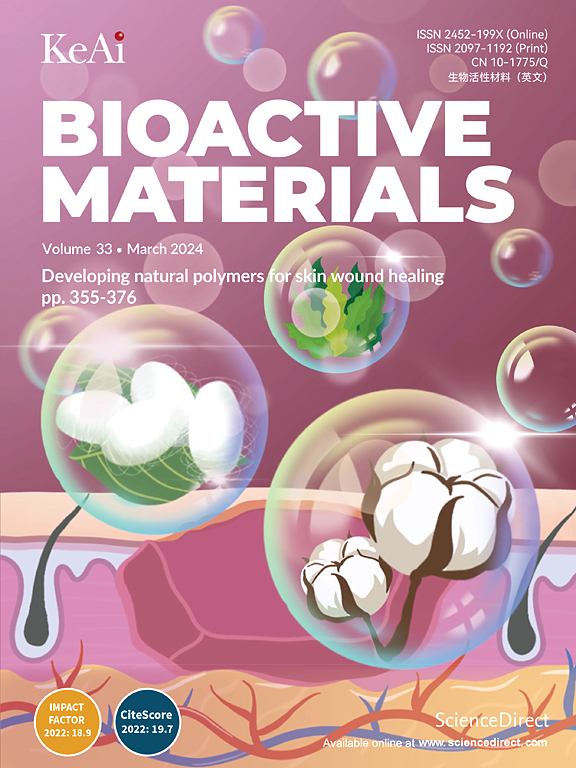Mesenchymal stromal/stem cell spheroid-derived extracellular vesicles advance the therapeutic efficacy of 3D-printed vascularized artificial liver lobules in liver failure treatment
IF 18
1区 医学
Q1 ENGINEERING, BIOMEDICAL
引用次数: 0
Abstract
Acute liver failure (ALF) is a highly lethal condition characterized by massive tissue necrosis, excessive oxidative stress, and serious inflammatory storms, necessitating prompt medical intervention. Although hepatocyte-like cells (HLCs) derived from mesenchymal stromal/stem cells (MSCs) offer a promising alternative cell source for hepatocyte therapy, their low in-vivo integration and differentiation efficiency may compromise the eventual therapeutic efficacy. To this end, MSCs are bioengineered into multicellular spheroids in the present study. The proteomic analyses and experimental results reveal that extracellular vesicles (EVs) derived from these MSC spheroids (SpEV) contain abundant highly expressed bioactive proteins and can be efficiently endocytosed by recipient cells, resulting in enhanced pro-angiogenic and antioxidative effects. In addition, MSC spheroids exhibit superior hepatic cell differentiation compared to an equivalent number of dissociated single MSCs, particularly when being co-cultured with hexagonally patterned endothelial cells in a liver lobule-like arrangement. Following orthotopic implantation in the mouse model, the enhanced paracrine effects of SpEV, combined with an immunoregulatory decellularized extracellular matrix hydrogel carrier and functional artificial liver lobules (ALL), synergically contribute to the effective amelioration of ALF, highlighting the substantial potential for clinical translation.

间充质基质/干细胞球体来源的细胞外囊泡提高了3d打印血管化人工肝小叶在肝衰竭治疗中的疗效
急性肝衰竭(ALF)是一种高度致命的疾病,其特征是大量组织坏死、过度氧化应激和严重的炎症风暴,需要及时进行医疗干预。虽然来自间充质基质/干细胞(MSCs)的肝细胞样细胞(hlc)为肝细胞治疗提供了一个有希望的替代细胞来源,但其体内整合和分化效率低可能会影响最终的治疗效果。为此,在本研究中,间充质干细胞被生物工程改造成多细胞球体。蛋白质组学分析和实验结果表明,源自这些MSC球体(SpEV)的细胞外囊泡(ev)含有丰富的高表达生物活性蛋白,可被受体细胞有效内吞,从而增强促血管生成和抗氧化作用。此外,与同等数量的分离的单个间充质干细胞相比,MSC球体表现出更高的肝细胞分化能力,特别是当与肝小叶样排列的六边形内皮细胞共培养时。在小鼠模型原位植入后,SpEV增强的旁分泌作用,结合免疫调节脱细胞细胞外基质水凝胶载体和功能性人工肝小叶(ALL),协同促进了ALF的有效改善,突出了临床转化的巨大潜力。
本文章由计算机程序翻译,如有差异,请以英文原文为准。
求助全文
约1分钟内获得全文
求助全文
来源期刊

Bioactive Materials
Biochemistry, Genetics and Molecular Biology-Biotechnology
CiteScore
28.00
自引率
6.30%
发文量
436
审稿时长
20 days
期刊介绍:
Bioactive Materials is a peer-reviewed research publication that focuses on advancements in bioactive materials. The journal accepts research papers, reviews, and rapid communications in the field of next-generation biomaterials that interact with cells, tissues, and organs in various living organisms.
The primary goal of Bioactive Materials is to promote the science and engineering of biomaterials that exhibit adaptiveness to the biological environment. These materials are specifically designed to stimulate or direct appropriate cell and tissue responses or regulate interactions with microorganisms.
The journal covers a wide range of bioactive materials, including those that are engineered or designed in terms of their physical form (e.g. particulate, fiber), topology (e.g. porosity, surface roughness), or dimensions (ranging from macro to nano-scales). Contributions are sought from the following categories of bioactive materials:
Bioactive metals and alloys
Bioactive inorganics: ceramics, glasses, and carbon-based materials
Bioactive polymers and gels
Bioactive materials derived from natural sources
Bioactive composites
These materials find applications in human and veterinary medicine, such as implants, tissue engineering scaffolds, cell/drug/gene carriers, as well as imaging and sensing devices.
 求助内容:
求助内容: 应助结果提醒方式:
应助结果提醒方式:


